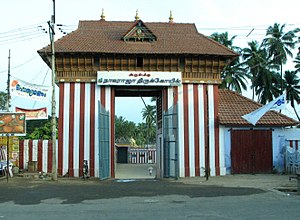Nagaraja Temple, Nagercoil
Nagaraja Temple (Tamil: Naga (serpent) + Raja (king)) is a Hindu temple temple dedicated to the god Nagaraja situated at the heart of Nagercoil. The name for the town Nagercoil originated from this temple. The temple is full of images of snakes. In addition, the gatekeepers of the sanctums are two snakes.
The head priest, who was interviewed in 2009, truly believes that it was originally a Dravidian Tamil Jain temple taken over by Hindus and rechristened as new mythological god by name Naga Raja.
Besides Nagaraja, there are images of Jain Tirthankaras, Mahavira and Parswanatha carved on the pillars of the temple. Total six Jain idols have been found from this temple. Mahavira's and Parsvanatha's idols are still being kept in the temple. The entrance is reminiscent of Chinese architecture of Buddha Vihara.
History
It is difficult to ascertain the exact age of the temple. There is no authentic epigraph to aid the historian with its chronology. The mountain Mahendragiri in the Kanyakumari district is referred to as the abode of nagas in the Ramayana of Valmiki. From this, it can be presumed that the origin of naga influence in the area goes back to legendary times.
From the five headed-serpent deity of the temple, the name of this place (town) Nagercoil is derived; gradually its old name, Kottar, has mostly faded. There is a part of town called Kottar, so the old name remains.With in five kilometer there is no human death for snake bite in current dates.

Traditional background
There is a traditional background regarding the origin of Nagaraja temple.
One day when a girl was cutting grass, blood began to spurt from below. She discovered that the sickle had cut into the head of a five-headed serpent. Dazed with fear, the girl fled to the nearest village and reported what she had seen. People in large numbers flocked to the spot and witnessed the miracle with their own eyes. By the joint effort of the villagers, the place was cleared and preserved for the purpose of worship.
They built a small shrine in the locality and worshiped the five-headed serpent. Hearing that the miracle happened at this place, people from other places visited the temple and offered poojas.
References
Nagaraja Temple (Tamil: Naga (serpent) + Raja (king)) is a Hindu temple temple dedicated to the god Nagaraja situated at the heart of Nagercoil. The name for the town Nagercoil originated from this temple. The temple is full of images of snakes. In addition, the gatekeepers of the sanctums are two snakes.
The head priest, who was interviewed in 2009, truly believes that it was originally a Dravidian Tamil Jain temple taken over by Hindus and rechristened as new mythological god by name Naga Raja.
Besides Nagaraja, there are images of Jain Tirthankaras, Mahavira and Parswanatha carved on the pillars of the temple. Total six Jain idols have been found from this temple. Mahavira's and Parsvanatha's idols are still being kept in the temple. The entrance is reminiscent of Chinese architecture of Buddha Vihara.
It is difficult to ascertain the exact age of the temple. There is no authentic epigraph to aid the historian with its chronology. The mountain Mahendragiri in the Kanyakumari district is referred to as the abode of nagas in the Ramayana of Valmiki. From this, it can be presumed that the origin of naga influence in the area goes back to legendary times.
From the five headed-serpent deity of the temple, the name of this place (town) Nagercoil is derived; gradually its old name, Kottar, has mostly faded. There is a part of town called Kottar, so the old name remains.With in five kilometer there is no human death for snake bite in current dates.
Traditional background
There is a traditional background regarding the origin of Nagaraja temple.
One day when a girl was cutting grass, blood began to spurt from below. She discovered that the sickle had cut into the head of a five-headed serpent. Dazed with fear, the girl fled to the nearest village and reported what she had seen. People in large numbers flocked to the spot and witnessed the miracle with their own eyes. By the joint effort of the villagers, the place was cleared and preserved for the purpose of worship.
They built a small shrine in the locality and worshiped the five-headed serpent. Hearing that the miracle happened at this place, people from other places visited the temple and offered poojas.
References
- The New Indian Express, Madurai edition, August 28, 2006.
- Sura's, Tourist guide to South India, 2004, ISBN 81-7478-175

No comments:
Post a Comment